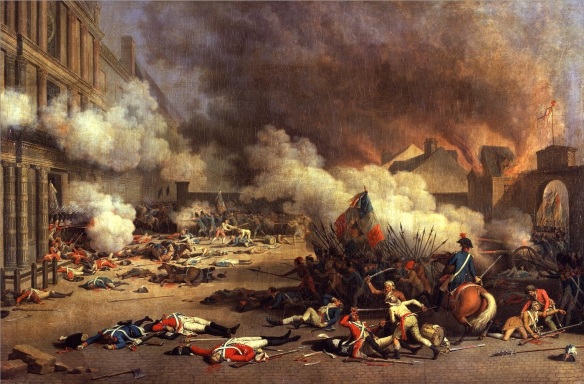Swiss regiments had historically fought as mercenaries in the armies of other nations, including that of France, long before the French Revolution. During the Revolution, the Swiss Guards of Louis XVI were massacred at the Tuileries on 10 August 1792. Eventually the Swiss took the side of the Revolution, forming the Helvetic Republic. Napoleon negotiated a convention with the Swiss in 1803. The agreement stated that the Swiss would provide four regiments to France, but no troops to any other nation. Swiss troops would be paid the same rate as French troops, and enjoy the same privileges. In addition, each Swiss regiment would have one Catholic and one Protestant chaplain, an unusual arrangement unknown in most of Napoleon’s forces.
On July 31, 1792, one of the more radical sections of the city of Paris issued an address to the people of France and their representatives in the Legislative Assembly. “For too long a despicable tyrant has played with our destinies,” it read. “Let us all unite to declare the fall of this cruel king, let us say with one accord, Louis XVI is no longer the king of the French.”
Three days later, Parisians awoke to find themselves and their city condemned to destruction if they moved against the Bourbon monarch. The commander of the Prussian Army, Charles William Ferdinand, Duke of Brunswick-Wolfenbüttel, had issued a proclamation that made public his intention to punish the French for their insult to royal authority and legitimacy. The duke sentenced the “city of Paris and all its inhabitants . . . to military execution and total destruction” unless the king was immediately restored to his former place and prerogative.
The response to Brunswick’s threat was virtually unanimous- and defiant. All 48 Paris sections, except one, demanded Louis’s abdication and a redoubling of the war effort. The sections’ spirits were lifted and their call for abdication was given renewed weight by the recent arrival in the capital of radical volunteers from Marseille bound for the front. Marching into Paris, the soldiers sang loudly the patriotic revolutionary song “La Marseillaise,” the words to which called the people “To arms! . . . So impure blood may water our soil!” This call for violence was echoed over the following days in the streets and in newspapers such as Marat’s L’ Ami du peuple.
The violence was realized on August 10. That day, leaders in Paris declared the city to be an independent commune and called for the abolition of the Bourbon monarchy. Led by sympathetic National Guardsmen, now utterly beyond Lafayette’s control, a crowd descended on the Tuileries palace. Terrified, the king and his family barricaded themselves in their chambers. Neither locked doors nor the presence of the Swiss Guard, however, could deter an infuriated mob determined “to attack the palace; exterminate everybody [and] force the king to abdicate.” The crowd numbering in the tens of thousands approached the palace, insisting that the king be brought before the National Assembly. With no option but to comply, Louis asked the Swiss to lay down their arms. The Swiss instinctively refused, and (witnessed by Napoleon) staunchly resisted the mob that rampaged through the courtyards of the palace. Of 800 Swiss Guards in Paris that day only 200 escaped; the rest were hunted down, and either killed on the spot or dragged off to prison and murdered a few days later. After this massacre the Swiss Diet ordered the withdrawal of all its regiments from France.
During the killing spree, Louis and his family escaped a similar fate only by slipping away and seeking refuge with the Legislative Assembly. The Swedish ambassador summed up the events of August 10 by writing that nothing could “describe the horror of yesterday. . . . For the moment the king has been divested of all his functions.” Robespierre, feeling that something momentous had taken place, took a different view of the carnage. Gloating over the king’s misfortune and animated by the sudden burst of radical energy, he saw the bloodshed as the hallmark of “the most beautiful revolution that has ever honored humanity.”
